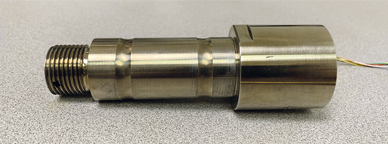
In space, temperatures, pressures and forces are different from those in the environments we are familiar with. This means that measurement technology “up there” is exposed to specific stresses. WIKA has now developed, tested and supplied special force transducers for space travel. These are customer-specific load pins that have now proven themselves on a flight into space.
Space travel has long been commercialised, and concepts for space tourism are taking shape. In the development departments of the space industry, plans are maturing for new generations of launch vehicles and other transporters for multiple, and thus resource-saving, missions. To bring passengers, crew and vehicles safely back to earth, sophisticated technology, reliable in every situation, is indispensable.
A central role is played by the flight control system, which ensures the correct orientation of the spacecraft for safe missions into space and back. Load pins are critical components for this. They must measure precisely the forces acting on the flight control surfaces of the spacecraft. Conventional load pins are not up to this task − the criteria for spacecraft force transducers are too demanding for them.
Requirements for force transducers in space travel
In the search for load pins suitable for space, an aerospace company had initially enquired with another manufacturer. But this supplier was not able to meet the extraordinary requirements. The load pins would have to:
- function reliably at extremely cold temperatures (down to -65 °C)
- withstand very high loads and be fatigue-proof
- have very compact dimensions (the diameter of the measuring bore was just 8 mm)
Many years of experience with load pins and miniaturisation

WIKA has developed and built this version of a load pin for a space mission.
In the end, the drawings, technical data and test requirements ended up at WIKA. Due to their many years of experience, both with load pins and also in instrument miniaturisation, WIKA’s force measurement experts succeeded in developing and manufacturing exactly the products that the customer had wanted.
But that was only the first challenge. The second was to subject the load pins to a multitude of tests in order to guarantee, with absolute certainty, that they would function correctly in space. However, the testing facilities needed for this were not available, neither internally nor externally. So how could the extreme operating conditions of the sensors be simulated?
Special test equipment for the space-travel force transducers
There was only one answer: WIKA had to design and build its own special test facility with a heating chamber and an adjustment and calibration machine. It had to be able to:
- apply an alternating load of 23,860 kg every seven seconds
- maintain an internal temperature of -65 °C
This new equipment ultimately provided proof that the load pins maintained the required measuring quality, even after 100,000 test cycles at the required low temperature. This was then also demonstrated in the application: The control surfaces of the spacecraft functioned perfectly and enabled a safe flight into space and back.
Measuring solutions for aviation too
In addition to space flight, WIKA also serves the aviation industry with specific measurement solutions. One example of this is the development of a force transducer as part of the European “Clean Sky” programme, which aims to reduce emissions from aircraft. WIKA also supplies DirectDrive pressure gauges for oxygen systems and pressure transducers for ice detection in jet engines.
Note
Further information on load pins and other force measurement technology for extreme conditions, for example ring force transducers and strain transducers, can be found on the WIKA website. You can also download a brochure with a compact overview of WIKA’s force measurement technology. If you have any questions, your contact will gladly help you.
Also read our posts
Force transducer: making air traffic cleaner
Force & power – what actually are they?
Load pins and the like: One product, various terms & areas of application
Anchor force measurement – a discipline that requires experience
The strain transducer in practical application

